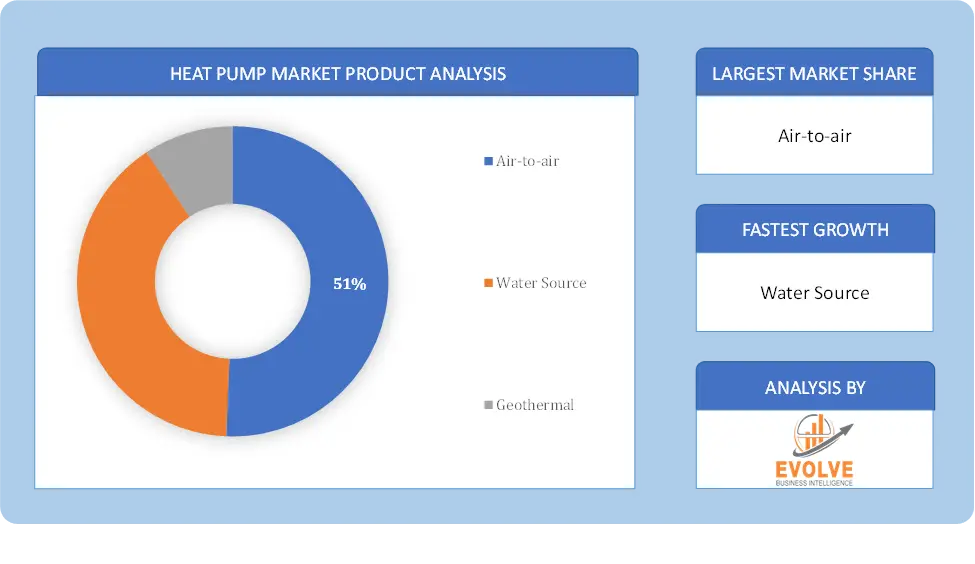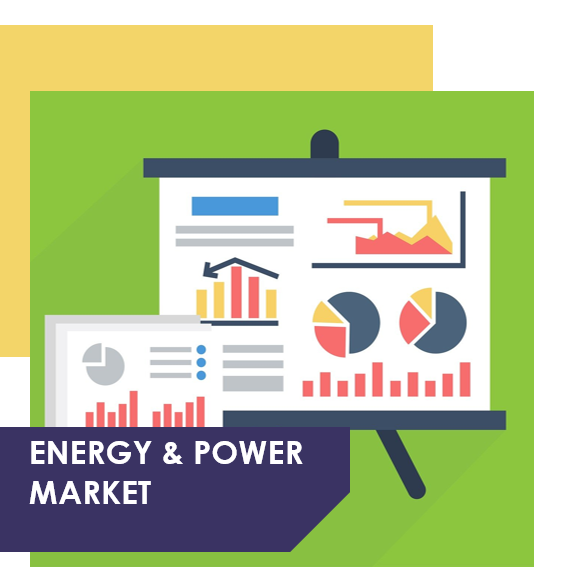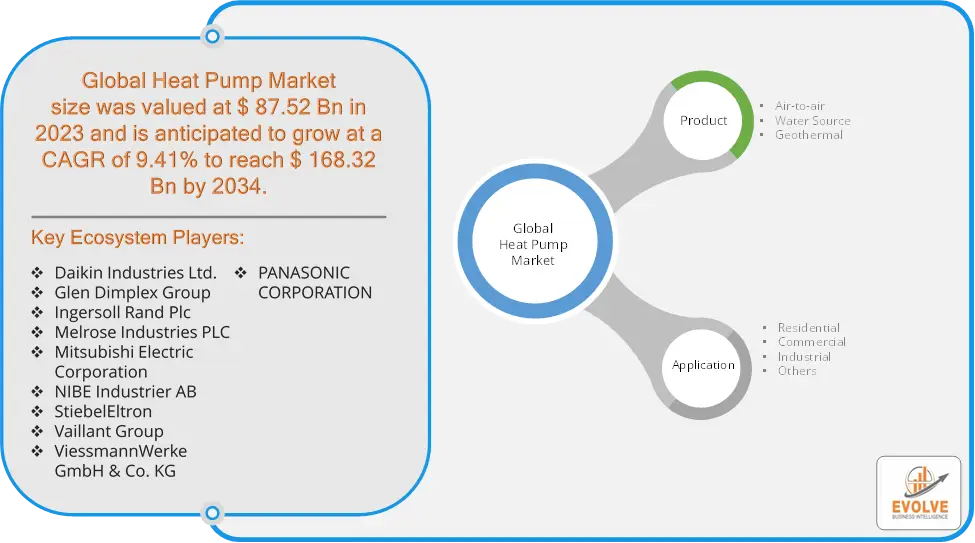Heat Pump Market Overview
The Heat Pump Market size accounted for USD 87.52 Billion in 2023 and is estimated to account for 90.41 Billion in 2024. The Market is expected to reach USD 168.32 Billion by 2034 growing at a compound annual growth rate (CAGR) of 9.41% from 2024 to 2034. The market for heat pumps is dominated by devices that move heat with the least amount of energy. These systems find use in commercial, industrial, and residential settings for both heating and cooling purposes. Growing consumer demands for energy efficiency, the move to renewable energy sources, and environmental laws supporting low-emission technology are the main factors driving market expansion. There are several varieties available in the market, including geothermal, water-source, and air-source heat pumps. Europe, North America, and Asia-Pacific are important areas, with substantial growth in colder climates as a result of technological advancements. Demand is also increased by rising energy costs and government incentives.
Global Heat Pump Market Synopsis
 Heat Pump Market Dynamics
Heat Pump Market Dynamics
The major factors that have impacted the growth of Heat Pump are as follows:
Drivers:
Ø Technological Advancements
Heat pump technology has advanced dramatically, increasing both its usefulness and performance. Modern heat pumps can function well in cooler areas because of advances in compressor, inverter, and refrigerant technologies. Once thought to be inefficient, these advancements have made air-source heat pumps more practical in areas with severe winters. Better energy management is made possible by its attractiveness, which is further enhanced by intelligent controls and integration with renewable energy sources like solar and wind power.
Restraint:
- Technical Complexity and Maintenance Needs
Compared to conventional heating and cooling systems, heat pumps are more complicated, necessitating specialist installation and maintenance services. End users may face additional difficulties as a result of this technological complexity since they may need to rely on trained personnel for maintenance and repairs. These systems may be harder to find and require more frequent maintenance in areas where there are fewer qualified installers and service providers. Concerns over long-term durability and the possibility of technical problems during the product’s lifetime are also raised by the systems’ complexity.
Opportunity:
⮚ Rising Demand for Energy-Efficient Solutions
There is a big chance for the heat pump market due to the rising demand for energy-efficient heating and cooling systems worldwide. Systems that provide lower energy usage and long-term savings are becoming more and more popular among businesses and homeowners as energy costs rise and governments impose higher efficiency regulations. Heat pumps are well-positioned to meet this demand because of their capacity to transmit more heat than they consume in energy. Heat pumps will become more widely used in the residential and commercial sectors as a result of the global trend toward energy-efficient building designs, which includes retrofitting older structures.
Heat Pump Segment Overview
By Product Type
 Based on Product Type, the market is segmented based on Air-to-air, Water Source, Geothermal. the air-to-air segment dominates due to its cost-effectiveness, ease of installation, and suitability for both heating and cooling in residential and commercial buildings.
Based on Product Type, the market is segmented based on Air-to-air, Water Source, Geothermal. the air-to-air segment dominates due to its cost-effectiveness, ease of installation, and suitability for both heating and cooling in residential and commercial buildings.
By Application
Based on Applications, the market has been divided into the Residential, Commercial, Industrial, Others. the residential segment dominates due to the increasing demand for energy-efficient heating and cooling solutions in homes, driven by rising energy costs and government incentives for sustainable technologies.
Global Heat Pump Market Regional Analysis
Based on region, the global Heat Pump market has been divided into North America, Europe, Asia-Pacific, the Middle East & Africa, and Latin America. North America is projected to dominate the use of the Heat Pump market followed by the Asia-Pacific and Europe regions.
 Heat Pump North America Market
Heat Pump North America Market
North America holds a dominant position in the Heat Pump Market. The market for heat pumps in North America was valued at USD 21.51 billion in 2021 and is anticipated to increase at a substantial CAGR over the course of the study. Growing consumer demand for energy-efficient systems, government programs to encourage emission reduction, and the adoption of clean and sustainable technologies by clean heating and cooling systems have all had a major impact on the rise in demand in North America. Furthermore, the increase in family units and population growth will hasten the residential market’s expansion.
Heat Pump Asia-Pacific Market
The Asia-Pacific region has indeed emerged as the fastest-growing market for the Heat Pump industry. According to projections, the heat pump market in Asia-Pacific would expand at the quickest rate possible between 2024 and 2030. It is caused by a number of things, such as the growing awareness of greenhouse gas emissions and climate change, as well as the growing demand in the residential and commercial sectors for energy-efficient heating solutions. In addition, the Asia-Pacific region’s fastest-growing heat pump market was India, while China held the greatest market share.
Competitive Landscape
The global Heat Pump market is highly competitive, with numerous players offering a wide range of software solutions. The competitive landscape is characterized by the presence of established companies, as well as emerging startups and niche players. To increase their market position and attract a wide consumer base, the businesses are employing various strategies, such as product launches, and strategic alliances.
Prominent Players:
- Daikin Industries Ltd.
- Glen Dimplex Group
- Ingersoll Rand Plc
- Melrose Industries PLC
- Mitsubishi Electric Corporation
- NIBE Industrier AB
- StiebelEltron
- Vaillant Group
- ViessmannWerke GmbH & Co. KG
- PANASONIC CORPORATION
Key Development
May 2022: To meet the growing demand for air-to-water heat pump and air conditioners in Europe, Mitsubishi Electric announced the expansion of the production capacity at its Turkey plant. To raise MACT’s yearly capacity for air-to-water (ATW) heat pump from its current capacity to 300,000 units, the business would invest USD 113 million.
Scope of the Report
Global Heat Pump Market, by Product
- Air-to-air
- Water Source
- Geothermal
Global Heat Pump Market, by Application
- Residential
- Commercial
- Industrial
- Others
Global Heat Pump Market, by Region
- North America
- US
- Canada
- Mexico
- Europe
- UK
- Germany
- France
- Italy
- Spain
- Benelux
- Nordic
- Rest of Europe
- Asia Pacific
- China
- Japan
- South Korea
- Indonesia
- Austalia
- Malaysia
- India
- Rest of Asia Pacific
- South America
- Brazil
- Argentina
- Rest of South America
- Middle East & Africa
- Saudi Arabia
- UAE
- Egypt
- South Africa
- Rest of Middle East & Africa
| Parameters | Indicators |
|---|---|
| Market Size | 2033: $168.32 Billion |
| CAGR | 9.41% CAGR (2023-2033) |
| Base year | 2022 |
| Forecast Period | 2023-2033 |
| Historical Data | 2021 |
| Report Coverage | Revenue Forecast, Competitive Landscape, Growth Factors, and Trends |
| Key Segmentations | Product Type, Application |
| Geographies Covered | North America, Europe, Asia-Pacific, Latin America, Middle East, Africa |
| Key Vendors | Daikin Industries Ltd., Glen Dimplex Group, Ingersoll Rand Plc, Melrose Industries PLC, Mitsubishi Electric Corporation, NIBE Industrier AB, StiebelEltron, Vaillant Group, ViessmannWerke GmbH & Co. KG, PANASONIC CORPORATION |
| Key Market Opportunities | • Increasing investments in the commercial and residential sector |
| Key Market Drivers | • Government regulations for increasing energy efficiency Rapid industrialization and increasing population would encourage energy-efficient equipment |
REPORT CONTENT BRIEF:
- High-level analysis of the current and future Heat Pump market trends and opportunities
- Detailed analysis of current market drivers, restraining factors, and opportunities in the future
- Heat Pump market historical market size for the year 2022, and forecast from 2021 to 2034
- Heat Pump market share analysis at each product level
- Competitor analysis with detailed insight into its product segment, Government & Defense strength, and strategies adopted.
- Identifies key strategies adopted including product launches and developments, mergers and acquisitions, joint ventures, collaborations, and partnerships as well as funding taken and investment done, among others.
- To identify and understand the various factors involved in the global Heat Pump market affected by the pandemic
- To provide a detailed insight into the major companies operating in the market. The profiling will include the Government & Defense health of the company’s past 2-3 years with segmental and regional revenue breakup, product offering, recent developments, SWOT analysis, and key strategies.







